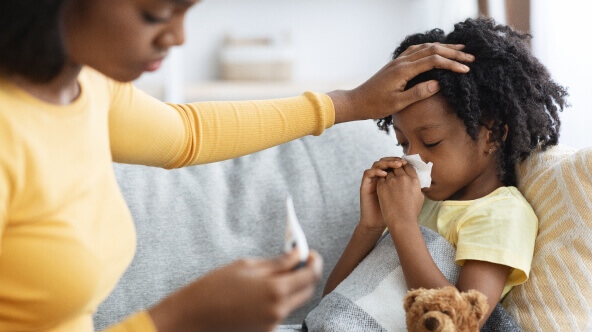Even before the COVID-19 pandemic, patients in a waiting room might recoil when someone sneezed, or a wandering toddler offered a toy. Now researchers have answered the question of whether spending time in an outpatient facility actually elevates patients’ risk of respiratory infection
Using athenahealth data and clever experimental design, researchers demonstrated that patients are significantly more likely to come down with an influenza-like illness (ILI) if exposed to other patients with such an illness in outpatient settings. Although their study, published in the August issue of Health Affairs, was based on pre-pandemic data, it has important implications for telehealth given the continuing threat of COVID-19 and other infectious diseases.
The study examined data from 105 million primary care visits
“There’s a lot of attention paid to hospital-acquired infections, a lot of policy directed to that,” said Hannah Neprash, Ph.D., an assistant professor of health policy and management at the University of Minnesota’s School of Public Health. “But little attention has been paid to the doctor’s office. Can you pick up infections there? The question hadn’t been answered.”
To find the answer, Neprash and researchers at Harvard Medical School and the Harvard T.H. Chan School of Public Health used deidentified billing and scheduling data from athenahealth’s EHR. The data encompassed more than 105 million adult patient encounters at 6,709 office-based primary care practices across the United States in 2016 and 2017.
“It is a ton of data, and even better, it is unique data which we can’t get elsewhere,” said Neprash. “We needed to see data on every patient who went through these primary care practices, not just Medicare patients’ data, for example.”
Were exposed patients more likely to return to the office with an ILI?
Neprash and her colleagues sought to quantify whether patients potentially exposed to patients with an ILI were more likely than unexposed patients to return to the office within two weeks with a flu-like illness. The hypothesis was that, on a given day at a medical office, patients seen at the same time or after an ILI patient might be exposed by contact with that ill patient or with shared surfaces.
Patients were classified as unexposed if their appointment time was at least 90 minutes before the office’s first visit of the day by a patient with influenza-like illness. All other patients were categorized as potentially exposed.
The researchers then examined whether each potentially exposed patient returned to the office with a flu-like illness, using data such as billing codes, orders for flu tests, and prescriptions for antiviral medications.
Results show that office exposure to flu increases infections
Neprash and her colleagues arrived at a clear result. “The answer is, yes, there is potential for viral transmission at outpatient clinics,” she said. The researchers observed a 31.8 percent increase in return visits for ILI among patients who had been exposed in their earlier visit, compared to patients who were not exposed. The authors calculated that approximately 5,140 excess ILI visits were potentially attributable to the patients’ earlier office visit with exposure to an ILI patient.
These results demonstrate that infection control is important in outpatient settings as well as hospitals. The researchers recognize that, through the COVID-19 pandemic, telehealth has emerged as a strategic tool for infection control with the full range of communicable diseases.
Implications for healthcare delivery and policy
The researchers believe their study has significant implications for telehealth practice and policy. For one, given the demonstrated potential for transmission of ILIs in medical offices, these facilities should consider adopting specific guidelines for triage to telehealth of patients with respiratory symptoms.
Further, as Congress addresses the future of telehealth, the researchers argue that the value of infection control should be considered. Narrowing the clinical scope of reimbursement for telehealth or reducing rates of reimbursement could drive some clinicians away from this infection-free modality of care delivery.
Neprash and her coauthors do acknowledge that telehealth comes with tradeoffs for respiratory patients, such as the inability to do a pulse oximeter reading during the visit. Telehealth also presents equity issues. “You do need access to high-quality internet,” which is less common in certain demographic groups, Neprash said.
Even with these caveats, the researchers believe telehealth should continue to play an important role in infection control at outpatient facilities.
Future research: Does COVID-19 act like ILIs in doctors’ offices?
The researchers see various avenues for further research into outpatient facility infections and their reduction. For one, mechanisms for transmission of respiratory infections – such as airborne virus particles versus contamination – are not well understood.
Which begs the question: How does the transmissibility of ILIs in outpatient facilities compare with the SARS-CoV-2 virus? Neprash and her colleagues would certainly like to know. “You might use data from the past year and a half and see if our hypothesis holds for COVID-19.”












